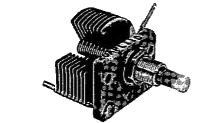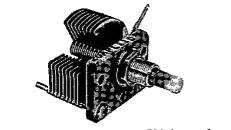Read the following text and answer the following questions on the basis of the same:
Tuning a radio set: In essence the simplest tuned radio frequency receiver is a simple crystal set. Desired frequency is tuned by a tuned coil/ capacitor combination, and then the signal is presented to a simple crystal or diode detector where the amplitude modulated signal, is demodulated. This is then passed straight to the headphones or speaker. In radio set there is an LC oscillator comprising of a variable capacitor (or sometimes a variable coupling coil), with a knob on the front panel to tune the receiver.
Capacitor used in old radio sets is gang capacitor. It consists of two sets of parallel circular plates one of which can rotate manually by means of a knob. The rotation causes overlapping areas of plates to change, thus changing its capacitance. Air gap between plates acts as dielectric.
The capacitor has to be tuned in tandem corresponding to the frequency of a station so that the LC combination of the radio set resonates at the frequency of the desired station.

When capacitive reactance (XC) is equal to the inductive reactance (XL), then the resonance occurs 1 and the resonant frequency is given by ω0=1√LC current amplitude becomes maximum at the resonant frequency. It is important to note that resonance phenomenon is exhibited by a circuit only if both L and C are present in the circuit. Only then do the voltages across L and C cancel each other (both being out of phase) and the Current amplitude is open, VmR, the total source voltage appearing across R.
This means that we cannot have resonance in a RL or RC circuit.
Resonance occurs only when:
A
XC=R
B
XL=R
C
XL=XC
D
XC>XL
Video Solution
Text Solution
The correct Answer is:C
At resonance, capacitive reactance (XC) is equal to the inductive reactance (XL). Circuit is totally resistive and the current amplitude becomes maximum.
|
Similar Questions
Knowledge Check
Read the following text and answer the following questions on the basis of the same:
Tuning a radio set: In essence the simplest tuned radio frequency receiver is a simple crystal set. Desired frequency is tuned by a tuned coil/ capacitor combination, and then the signal is presented to a simple crystal or diode detector where the amplitude modulated signal, is demodulated. This is then passed straight to the headphones or speaker. In radio set there is an LC oscillator comprising of a variable capacitor (or sometimes a variable coupling coil), with a knob on the front panel to tune the receiver.
Capacitor used in old radio sets is gang capacitor. It consists of two sets of parallel circular plates one of which can rotate manually by means of a knob. The rotation causes overlapping areas of plates to change, thus changing its capacitance. Air gap between plates acts as dielectric.
The capacitor has to be tuned in tandem corresponding to the frequency of a station so that the LC combination of the radio set resonates at the frequency of the desired station.

When capacitive reactance (XC) is equal to the inductive reactance (XL), then the resonance occurs 1 and the resonant frequency is given by ω0=1√LC current amplitude becomes maximum at the resonant frequency. It is important to note that resonance phenomenon is exhibited by a circuit only if both L and C are present in the circuit. Only then do the voltages across L and C cancel each other (both being out of phase) and the Current amplitude is open, VmR, the total source voltage appearing across R.
This means that we cannot have resonance in a RL or RC circuit.
Resonance frequency is equal to:A1LCB1/√LCC√LCD√CLRead the following text and answer the following questions on the basis of the same:
Tuning a radio set: In essence the simplest tuned radio frequency receiver is a simple crystal set. Desired frequency is tuned by a tuned coil/ capacitor combination, and then the signal is presented to a simple crystal or diode detector where the amplitude modulated signal, is demodulated. This is then passed straight to the headphones or speaker. In radio set there is an LC oscillator comprising of a variable capacitor (or sometimes a variable coupling coil), with a knob on the front panel to tune the receiver.
Capacitor used in old radio sets is gang capacitor. It consists of two sets of parallel circular plates one of which can rotate manually by means of a knob. The rotation causes overlapping areas of plates to change, thus changing its capacitance. Air gap between plates acts as dielectric.
The capacitor has to be tuned in tandem corresponding to the frequency of a station so that the LC combination of the radio set resonates at the frequency of the desired station.

When capacitive reactance (XC) is equal to the inductive reactance (XL), then the resonance occurs 1 and the resonant frequency is given by ω0=1√LC current amplitude becomes maximum at the resonant frequency. It is important to note that resonance phenomenon is exhibited by a circuit only if both L and C are present in the circuit. Only then do the voltages across L and C cancel each other (both being out of phase) and the Current amplitude is open, VmR, the total source voltage appearing across R.
This means that we cannot have resonance in a RL or RC circuit.
Name the phenomenon involved in tuning a radio set to a particular radio station.AStabilizationBRectificationCResonanceDReflectionRead the following text and answer the following questions on the basis of the same:
Tuning a radio set: In essence the simplest tuned radio frequency receiver is a simple crystal set. Desired frequency is tuned by a tuned coil/ capacitor combination, and then the signal is presented to a simple crystal or diode detector where the amplitude modulated signal, is demodulated. This is then passed straight to the headphones or speaker. In radio set there is an LC oscillator comprising of a variable capacitor (or sometimes a variable coupling coil), with a knob on the front panel to tune the receiver.
Capacitor used in old radio sets is gang capacitor. It consists of two sets of parallel circular plates one of which can rotate manually by means of a knob. The rotation causes overlapping areas of plates to change, thus changing its capacitance. Air gap between plates acts as dielectric.
The capacitor has to be tuned in tandem corresponding to the frequency of a station so that the LC combination of the radio set resonates at the frequency of the desired station.

When capacitive reactance (XC) is equal to the inductive reactance (XL), then the resonance occurs 1 and the resonant frequency is given by ω0=1√LC current amplitude becomes maximum at the resonant frequency. It is important to note that resonance phenomenon is exhibited by a circuit only if both L and C are present in the circuit. Only then do the voltages across L and C cancel each other (both being out of phase) and the Current amplitude is open, VmR, the total source voltage appearing across R.
This means that we cannot have resonance in a RL or RC circuit.
Capacitor used in radio set for tuning is a:Aparallel plate capacitorBspherical capacitorCpaper capacitorDelectrolytic capacitor
When temreture increases, the frequency of a tuning fork
View SolutionWhen temperature increases, the frequency of a tuning fork
View SolutionThe prongs of the tuning fork are filed, then the frequency of the tuning fork after filing will be
View SolutionConsider tuning a radio to higher frequency station. The energy of radio photons detected
View SolutionThe prongs of the tuning fork are filled a little, the frequency of the tuning fork after filled
View Solution

